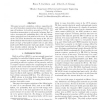Free Online Productivity Tools
i2Speak
i2Symbol
i2OCR
iTex2Img
iWeb2Print
iWeb2Shot
i2Type
iPdf2Split
iPdf2Merge
i2Bopomofo
i2Arabic
i2Style
i2Image
i2PDF
iLatex2Rtf
Sci2ools
VTS
1998
IEEE
1998
IEEE
Transition Maximization Techniques for Enhancing the Two-Pattern Fault Coverage of Pseudorandom Test Pattern Generators
This paper presents simulation evidence supporting the use of bit transition maximization techniques in the design of hardware test pattern generators TPGs. Bit transition maximization is a heuristic technique that involves increasing the probability that a bit will change values going from one test pattern to the next. For most of the ISCAS-85 benchmarks and many of the ISCAS89 benchmarks bit transition maximization enhances the fault coverage of two-pattern faults such as gate delay faults and CMOS transistor stuck-open faults. It achieves these bene ts without reducing the fault coverage with respect to classical stuck-at faults.
Benchmarks Bit Transition | Bit Transition Maximization | Hardware | Transition Maximization Techniques | VTS 1998 |
| Added | 05 Aug 2010 |
| Updated | 05 Aug 2010 |
| Type | Conference |
| Year | 1998 |
| Where | VTS |
| Authors | Bruce F. Cockburn, Albert L.-C. Kwong |
Comments (0)

